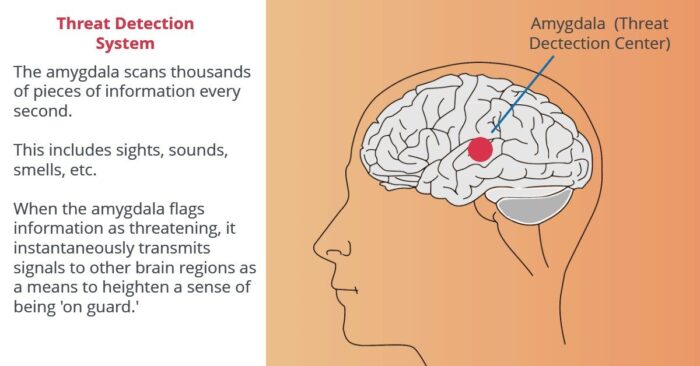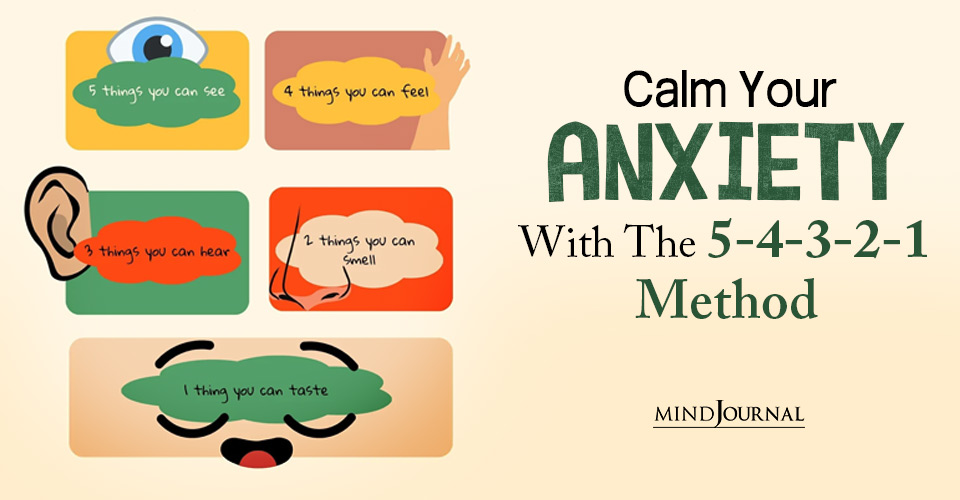There are different types of anxiety disorders, mainly five forms of anxiety that can make your mind a hellish place to be. However, interestingly, all these five common anxiety disorders have the same cause. Interested to know what that is? Let’s explore the five different types of anxiety disorders and the common cause behind them.
From time to time everyone feels anxious. It is part of the human condition.
What’s more, it can be helpful. Anxiety is your brain’s way of signaling that something needs your attention, and if you fail to respond there could be painful consequences.
Anxiety disorders occur, however, when this signaling system malfunctions. That is, your brain creates a sense of anxiety but, objectively, there is no threat that requires your attention.
The ‘early warning detection center’ in your brain is called the amygdala. It is a small almond-shaped structure buried deep within the center of your grey matter.
One of its primary roles is to detect if there is something threatening to which you need to respond. This might be a shark, a mountain lion, an intruder, or even a utility bill that has not yet been paid.
Related: Self Help For Anxiety Attacks: 22 Ways To Get Through Anxiety, Stress, And Panic
When the amygdala processes information indicating that a threat is present, it signals other areas of the brain, which in turn send signals throughout the body preparing for a defensive response.
Often times this means your heart rate increases, digestion is slowed, pupils dilate, and other physiological reactions take place. All of this can occur because the amygdala has, outside your conscious awareness, detected a threat.
Just like a home alarm system, your amygdala can make an error. It can signal that a threat is present when, in fact, all is well.

Sometimes, due to genetics or one’s personal history (or both), the amygdala becomes overly sensitive. It begins to frequently send out false threat signals.
When you are feeling anxious and there is no reason to be ‘on guard’, that’s your amygdala being overly protective.
It is like having a bodyguard who is so determined to keep you safe he won’t leave your side… ever. In fact, he tackles you to the ground when a small poodle comes into view. Keeps you awake at night sitting at the foot of your bed. Carefully checks your closet before you get dressed in the morning. He might even lock you in the house just in case there is a sudden downpouring of acid rain.
You get the idea.
Re-tuning The Amygdala
Correcting a faulty threat detection system is important. You need a balance between maintaining a healthy awareness of real threats to your well-being and having minimal false alarms.
Living with faulty alarm bells constantly going off creates stress, and this results in all kinds of responses that limit your ability to live life fully (e.g., distrusting others, always being ‘on guard’, avoiding people and places that would otherwise be rewarding, poor sleep, and so forth).
Fortunately, your overactive threat detection system can be ‘re-tuned.’ It can become what it was meant to be: an ally in keeping you safe, rather than an overprotective guard dog that ruins your happiness.
The general approach for re-tuning this part of your brain is to teach your amygdala to be better at distinguishing a real threat from a false threat.
This requires that an anxious person confront the thing that falsely gives rise to fear. Repeatedly doing this, over time, usually results in calm and confidence replacing fear and trembling.
Depending upon the fear this could involve confronting situations where you are in a crowd, giving a speech, flying on an airplane, finding a spider in the bathtub, etc.
Cognitive behavioral therapists call this approach to re-tuning your amygdala ‘exposure therapy.’
Although it can be unpleasant (because confronting those things that you fear is initially aversive), it is effective. Most people who undertake this type of therapy experience significant improvement.
Exactly how this sort of therapy proceeds will vary according to the type of anxiety you experience. Although the underlying principle remains the same, the exact strategies used for achieving success differ depending on the form of anxiety being confronted.
The takeaway message is that having an anxiety disorder is not the mark of weakness, and should not be seen as an unsolvable problem. It just involves some persistence, a good plan, and a little time.
Below I’ve described the five most common types of anxiety disorders. It may be that after reading these descriptions you think one of them fits what you are experiencing.
If that’s the case then keep this in mind: you can retrain your brain and end up living a happier life. Each of these forms of anxiety responds well to therapy. It is likely that your anxiety, after therapy, will be drastically reduced.
What are the five major anxiety disorders?
Related: What Causes Anxiousness? 9 Factors That Lie At The Root Of Anxiety
5 Major Types Of Anxiety Disorders
1. Generalized Anxiety Disorder.
This is sometimes referred to by its abbreviation, GAD. It is characterized by chronic fear, stress, tension, and worries even in the absence of objective threats to one’s well-being.
2. Social Anxiety
Sometimes referred to as Social Phobia, people who struggle with this form of anxiety experience extreme fear and painful self-consciousness when dealing with everyday social situations. This may include talking with co-workers, going to a party, or ordering a meal.
Although social anxiety may be limited to only one type of situation (e.g., giving a presentation in class), most often it occurs over a broad spectrum of social situations. When it is at its worst, it may lead to the person becoming homebound, afraid to walk out the front door of their house (agoraphobia).

3. Panic Disorder
This disorder is characterized by the experience of having extremely strong feelings of dread and fear that occur unexpectedly (and on more than one occasion).
These attacks may last from ten minutes to an hour or more and create within the person an overwhelming sense that something horrible is about to happen over which they have no control. Most often the person will be unable to identify what he/she believes is about to occur, only that it is cataclysmic.
People having panic attacks often describe themselves as wanting to run away, but not knowing what they are running from. Dizziness, shortness of breath, sweating, and other physical reactions typically occur with a panic attack.
4. Obsessive-Compulsive Disorder (OCD).
Someone with OCD struggles with having unrealistic, intrusive, and recurrent thoughts or urges that result in anxiety. These are called ‘obsessions’ because the person dwells on the thoughts and finds it difficult not to do so.
The other key feature of OCD is that the person will often cope with the anxiety by engaging in specific unnecessary behaviors that end up reducing his or her anxiety.
An example of this is the person who chronically worries that he has not locked his car (this is the obsession), and consequently returns to his car multiple times in order to double-check that the doors are locked (this is the compulsion).
After the fifth or sixth time of checking the doors, he feels reassured enough to stop checking.
Related: What is Obsessive Compulsive Disorder (OCD): Symptoms, Causes and Treatment
5. Post-Traumatic Stress Disorder (PTSD)
Develops after someone experiences a terrifying event. Typically these events involve a life-threatening circumstance (either for oneself, or someone else), and a feeling of being helpless.
Being in a house struck by a tornado, carjacking, many combat scenarios, rapes, muggings, and so forth are the sorts of experiences that can lead to PTSD.
The threat may be directed at oneself or others near the individual. For example, it is not unusual for first responders to develop PTSD after assisting in particularly gruesome accidents.
With PTSD anxiety arises after the traumatic incident in response to reminders of the threatening situation. For example, some veterans of the Iraq and Afghanistan wars who were in vehicles hit by IEDs would return stateside and find that driving precipitated a strong anxiety reaction.
Or, for example, if a woman was raped by a man wearing a red shirt she may later find herself getting anxious when in the company of men wearing red.
This reaction, at first, would be difficult for her to understand. Despite her fears to the contrary, she would not be “going crazy.” Instead, her threat detection system is simply at work and associates the color red with the state of being in an unsafe situation. This, in turn, triggered an alarm reaction by her amygdala.
Fortunately, with the right help, she would be able to retrain her brain and regain a sense of confidence and calm.

Conclusion
Any system within the human body can malfunction. This includes the human nervous system’s threat detection center. When it malfunctions by becoming overly sensitive, anxiety disorders may occur.
The five most common anxiety disorders include Generalized Anxiety Disorder (GAD), Social Anxiety, Obsessive Compulsive Disorder (OCD), Panic Disorder, and Post Traumatic Stress Disorder (PTSD).
Although each of these disorders is unpleasant to experience and can become a major impediment to a full and happy life, there are effective ways to fight back. Anxiety can be tamed.
Related: How To Cope With Anxiety And Depression During Christmas: 14 Ways To Bring Some Cheer
With the proper approach, persistence, and determination, success and a fuller, happier life, can be your reward.
Written By Forrest Talley Originally Appeared On Forrest Talley









Leave a Reply
You must be logged in to post a comment.